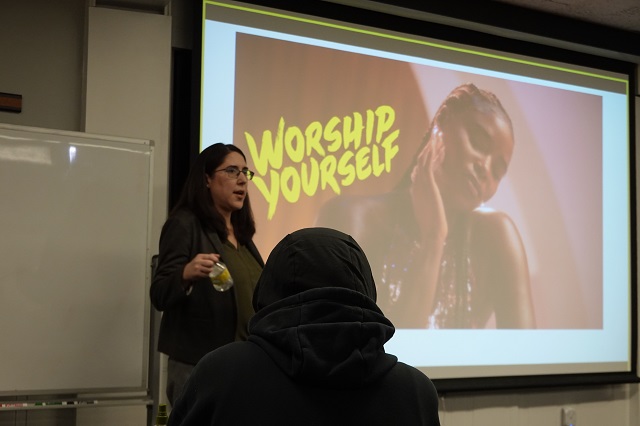At the Professional Science Master’s program, we strive to provide our students with insight from experts. This is accomplished through our alumni-student mentoring program, guidance from our Industrial Advisory board, networking events we host, and by inviting industry professionals into our classrooms.
On February 23rd, at the Rutgers University Inn and Conference Center, Professor Mark Burgess hosted Wendy Bishop to give a lecture entitled "The Roadmap to a Successful New Product Launch" for his course Market Assessment and Analysis for Business and Science.
Bishop is the Marketing Director of Haircare at Church & Dwight Co., Inc. She has over 22 years of experience working in the consumer packaged goods industry, and she leads the Church & Dwight Employee Giving Fund. Bishop is a Rutgers alum, having received her MBA here.
In her presentation, Bishop detailed how new products are developed from idea to launch, overcoming obstacles along the way. She used the Nair product Prep and Smooth Face Hair Remover as a case study, illustrating how Nair has reinvented itself to pursue a new demographic and enter the beauty space.
Here are some key takeaways from her presentation.

Learning is transferable.
The insight gained from past projects can provide you with new perspectives as you take on new roles. Bishop drew from her own personal experience, having managed over two dozen brands within different categories and spearheaded a new Innovation process for the company in 2019.
There are four critical components for successful launches.
Bishop highlighted four key elements for a successful product launch.
-
Desirability for consumers. Use customer insight to create a product that a consumer really needs. This can be done using consumer reviews, trends, social listening, surveys, and brainstorming sessions. Develop this insight into a new concept that resonates with consumers. In the case of Nair, the team noticed the rise of dermaplaning and hair removal as a skincare step. Other factors to consider include packaging and price point.
-
Business viability. Ensure that the product is financially viable. Test the concept to guarantee that it resonates with consumers, catches their attention, is unique to its category, and is incremental to the brand. Decide whether you can sell this product and make the desired profit.
-
Technical feasibility. Ensure that the concept can be turned into a product by your research and development team.
-
Ensure continuing success after launch.
Create a sell-in.
When launching a product, stakeholders need to buy into the product. Here are the stakeholders to consider when creating a sell-in plan.
-
Brand. Consider how the product fits within the brand, and whether it will align with the brand’s projected path.
-
Consumer. Determine whether the product will fulfill a customer need, examining the core benefit of the product and its reason for being. Does it bring something new to the market, offer something different, or improve upon an existing product?
-
Retailer. Reveal how this product will grow the category for the retailer and increase their profit.
-
Company. Examine how the product will be profitable and drive incremental net sales. Determine the long-term opportunity and sustainability of the product.
Execute an omnichannel marketing plan.
Ensure that your product has a consistent presence across multiple channels. These channels can include e-commerce websites as well as in-store presence.
Professor Burgess will host his next speaker on March 2nd: Kelly Patraju (an MBS alumni!) will give a lecture entitled “The Real-life Applications and Processes of Product Management.” Read about Professor Burgess’ class trip to IKEA, where students studied the store’s experiential marketing tactics first-hand.
To find more workshops, speakers, and panels, visit our events page. You can also stay up to date by following us on Twitter and LinkedIn.